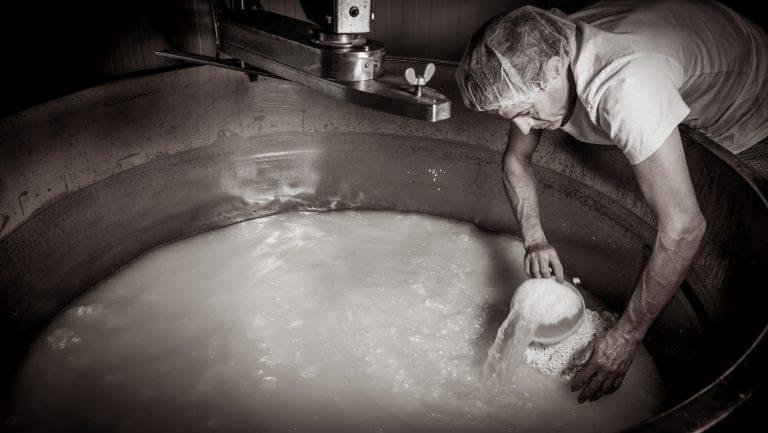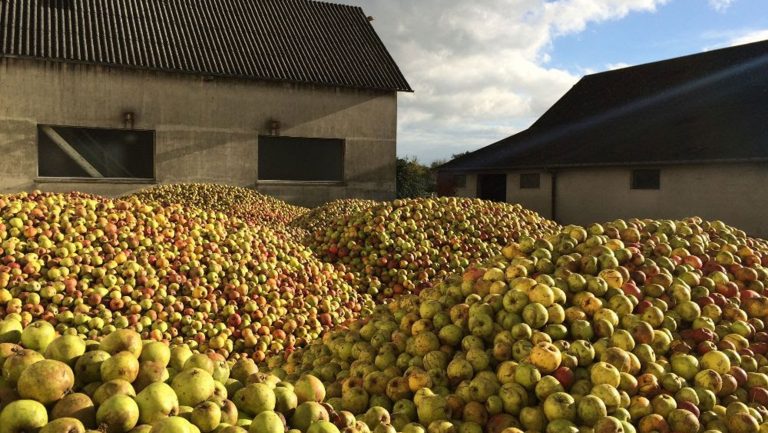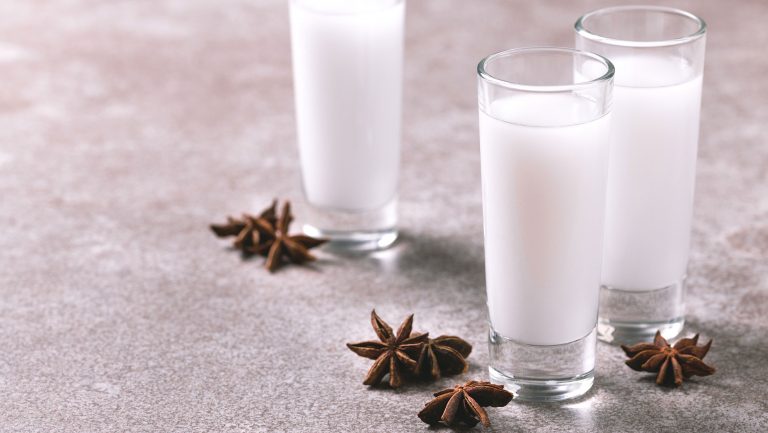Over the last several years, a smattering of bottles of whey-based spirits have been popping up on the shelves at both bars and retail shops around the world. At first, the use of whey seemed like the latest gimmicky hook for marketing spirits, but could whey—the leftover liquid by-product from dairy processing—have the potential to provide a sustainable base for distillate?
Nicole Austin, the distiller and general manager of Cascade Hollow Distilling in Tullahoma, Tennessee, thinks so. When Austin was president of the New York State Distillers Guild (2012 to 2015), she often attended meetings with representatives from different agricultural sectors—including dairy. At the time, yogurt production in New York State was on the rise. The topic of whey waste came up often enough that Austin, who has a chemical engineering background and worked in waste management, started thinking about its viability as a fermentable base for distillation.
Austin’s experience in waste management gave her a keen awareness of the issues involved in various types of waste processing. Whey, she says, “is so dilute—it takes a lot of space to manage it. I heard about that [problem] a lot.” It’s what inspired her to begin working on a sustainable solution.

Don’t miss the latest drinks industry news and insights. Sign up for our award-winning newsletters and get insider intel, resources, and trends delivered to your inbox every week.
She believed that whey could be processed more sustainably and put to use, and she began to pursue the goal of producing a neutral spirit with whey. It would be a way to help meet the craft spirit industry’s demand for the product while creating a more sustainable, circular economy with whey waste.
Austin planned to use a specialized process to ferment the whey and distill it into a neutral spirit. She explains that, normally, to process whey and make it safe for disposal, an anaerobic digester is used to “basically make the [waste] material inert, so that it won’t cause serious environmental problems if released.” But if a distiller is going to ferment the whey, the dairy doesn’t have to prepare the whey for disposal. This can make selling the whey to distilleries more cost-effective for the dairies. “What I really liked about the idea of making spirits from [the waste] is that it relieves the dairy from having to manage the whey—and it generates a beneficial product.”
Unfortunately, Austin wasn’t able to secure the funding necessary to bring her project to fruition. “No one at that time,” she says, “was going to give a 27-year-old woman the millions to make it happen.” But, she says, it’s a concept she still stands behind.
Upcycling and Fermenting Whey
Paul O’Callaghan is a water technology expert and the founder of O₂ Environmental, a company with offices in Cork, Ireland, and Vancouver, Canada, that strategizes opportunities for managing and creating value for water or industrial by-products—for example, whey. Like Austin, O’Callaghan believes that whey can serve as a sustainable base for distillate in spirits production. “[Liquid whey] is 95 percent water,” he says, “and 1 to 5 percent lactose—enough to ferment.” The lactose can become more concentrated after proteins are filtered out and water is removed, and with the right yeast strains and enzymes, it can be fermented into alcohol.
Whey can be upcycled in a few ways. Since water is an integral part of distillation—used for everything from irrigating crops and boiling grain into wort to cooling down stills and diluting spirits for proofing—choosing a reusable liquid by-product like whey to serve as a spirit’s base for distillate could potentially help conserve water. Consulting distiller Dave Pickerell of Oak View Spirits in Mount Washington, Kentucky, points out, for example, that distillers can “get creative and re-use the water in the whey’s liquid waste as a coolant in the condenser.”
Whey waste has also traditionally been repurposed as feed for farm animals, an especially common practice among small producers of cheese, milk, and yogurt. For farmers who have surplus whey, selling it is an option. “The story of whey is as old as dairies and cheeses,” says O’Callaghan. For thousands of years, he says, traditional solutions for dealing with whey waste were an inherent part of good animal husbandry.
In a 2011 report on turning whey waste into potable alcohol, O’Callaghan found that the potential existed for producing over 200 million gallons of ethanol from American whey waste. “I’ve done a more recent search on the data,” he says, “and it shows that this figure is still valid and in the correct range.” A whey-based wash typically yields approximately 2.5 percent ethanol, which can then be distilled.
Managing Whey Waste
Jonathan White, a chemical engineer turned artisanal cheese maker, started a farm-based dairy, Bobolink Dairy and Bakehouse, in Milford, New Jersey, with his wife, Nina, in 2002. He believes that upcycling whey for spirits production would be a valid option for dealing sustainably with the waste. The problem, he says, is that “most of the whey in the U.S. economy is from … [large industrial] plants [that are] producing a million pounds of whey waste a day.” They’re not focused on sustainability efforts, he says—“They’re resource extractors.”
The USDA has reported that 90.5 billion pounds of whey waste is produced annually, yet until recently, a scant 35 percent of it was put to use—and not by the spirits industry, according to O’Callaghan. Most of that waste is upcycled for biofuel and consumer products like whey protein isolate (WPI), or protein powder.
“WPI is actually an amazing product,” says Donnie Fike, a dairy products statistician with the USDA National Agricultural Statistics Service Livestock Branch. “It’s a dry powder that’s 90 percent protein.” Fike explains that the production of WPI has helped cut down on whey waste. “In 2003,” he says, “the first year we started having data [on WPI from whey waste], production of WPI was 22.3 million pounds. In 2017, production was over 116 million pounds.” Even with more whey waste being upcycled for uses such as WPI products, the major part of it, he says, is still discarded.
The Whites use the whey waste from their grass-fed cows to feed their pigs, which are later butchered for meat. While they don’t currently have excess whey to sell, White says that small- and medium-sized dairies that do have a surplus might find that selling to craft distillers could be a worthwhile option. Even though whey is mostly water, dairies can’t just dump it, because of the lactose and protein, which need to be separated out before the waste can be disposed of; the waste must therefore be trucked to a processing plant—which, says White, entails further costs.
He concedes, however, that this option may not have as much appeal for large industrial plants. In their case, White says, whey waste is considered a disposable liability—it costs money to get rid of it, and whatever the waste could sell for—to a distiller, for example—might not allow the industrial dairy producer to actually break even. “The cost of transporting the waste [for the industrial plant],” White says, “[would] negate its value.”
The economic viability of whey as a base for distillate may ultimately be contingent on distillers’ ability to get access to cheap or free liquid whey, which may be more of a possibility for craft distilleries in states like Vermont and New York, where there are numerous burgeoning artisanal dairies from which the distillers could potentially source whey.
Producing Whey-Based Spirits
These days, whey-based craft spirits are being produced in Ireland (Bertha’s Revenge Irish Milk Gin by Ballyvolane House Spirits Company, and Blackwater No. 5 Gin by Blackwater Distillery), England (Black Cow Pure Milk Vodka), France (Lactilium Vodka by the Mandracore Spirits group), New Zealand (VDKA 6100 by Artisan Spirits Merchants and Broken Shed by Broken Shed Distilleries), Australia (Sheep Whey Gin by Hartshorn Distillery), Canada (Bob’s Super Smooth by Black Fly Beverage Company), and the U.S. (Vermont Spirits White Vodka, and Mountain Spirits Distilling in New York State).
Jason Barber, a dairy farmer and the cofounder, with Paul Archard, of the Black Cow Pure Milk Vodka distillery in West Dorset, England, has chosen to use the excess whey from his dairy farm in an effort to upcycle it. “It takes about 17 to 18 liters [of whey waste],” he says, “to produce a liter of Black Cow at 40% [ABV].” Barber and Archard turn around and sell each 70-centiliter bottle of the vodka for about US$40. “My family,” Barber says, “are the oldest cheddar cheese makers in the world, so I have plenty of the best raw material.”
Dan Paquin and John Whiteman, codistillers at Mountain Spirits Distilling in Plattsburgh, New York, use a concentrated lactose permeate—the result of whey that has gone through reverse osmosis—to make their whey-based vodka Driven Snow. “The one reason I think a lot of distillers aren’t pursuing whey-based spirits,” says Paquin, “is it’s tricky in terms of enzyme conversion.”
Fermenting whey is not as easy as fermenting grains like wheat or corn, mainly because of the low alcohol yield after fermentation. It also depends on the type of whey you’re fermenting. Sweet whey from hard cheeses like cheddar, for example, is a little easier to ferment than acid—or sour—whey from yogurt. Additionally, because whey proteins are unstable, the potentially higher cost of handling and processing whey may make it less appealing than other bases for distillate. Whey must be processed as soon as it’s separated from the cheese curd, or else there’s a risk of bacterial growth that can cause protein to degrade and lactic acid to form.
The Future of Whey in the Drinks Industry
Eamon Rockey, a New York City restaurant veteran and the founder of Rockey’s Milk Punch, recently launched a shelf-stabilized bottled milk punch product. He uses whey that he makes himself as a base ingredient in the punch (to be clear, though, whey is not used as a base in any of the spirits contained in the punch). He encourages the collaboration between large dairy companies and distillers.
“Now is the time,” he says, “for someone to go to Dannon and say, ‘Hey, spin-off business!’ As long as there are fermentable sugars, you have something that can absolutely produce ethanol—that can carry through distillation to produce a neutral or other distillate that would otherwise be waste.” While using whey as a base for distillate is not a new concept, Rockey suggests that there is now a greater degree of interest in experimenting with whey, particularly because of its association with sustainability.
But experimenting with whey is expensive, Austin points out. “The tipping point of profit is not until you arrive at 50,000 cases, or 115,000 proof gallons,” she says. “Anything less than a million gallons a year is not worth getting out of bed for.” However, she says, a company like the one she’d envisioned during her tenure at the New York State Distillers Guild, one that could successfully make large amounts of neutral spirit from an upcycled by-product like whey, would have not only good potential for financial success but the capacity to make a significant, positive impact on the environment.
For now, though, the use of whey as a distillate base is off to a slow start—and there still seem to be some kinks to work out, from the details of a more complicated fermentation process to problems of sourcing. If the small dairies are using their whey to feed their own farm animals and have none to spare, and the big dairies are producing so much that it doesn’t pay them to take the call of a craft distiller who wants a 100-gallon carboy of whey, perhaps the future of whey-based spirits lies somewhere in the middle—with a collaboration between sustainably minded craft distillers and midsized dairies.
For Austin, it still seems like a smart and responsible way to manage the making of two separate products—the dairy product and the spirit—and the waste they create. “This is a way to capture every last drop of this agricultural product we use,” she says, “and make it value-added and a benefit to doing business in the spirits industry.”

Dispatch
Sign up for our award-winning newsletter
Don’t miss the latest drinks industry news and insights—delivered to your inbox every week.
Amy Zavatto is the author of Prosecco Made Me Do It: 60 Seriously Sparkling Cocktails, Forager’s Cocktails, and The Architecture of the Cocktail. Her stories appear in Liquor.com, Imbibe, Beverage Media, and many others. She judges at the American Craft Spirits Association annual competition and the New York Wine & Food Classic, and she earned her Level III Certificate from the Wine & Spirits Education Trust, but her favorite way to learn is through taste and travel. She’s a big fan of underdogs and talking with her hands.







